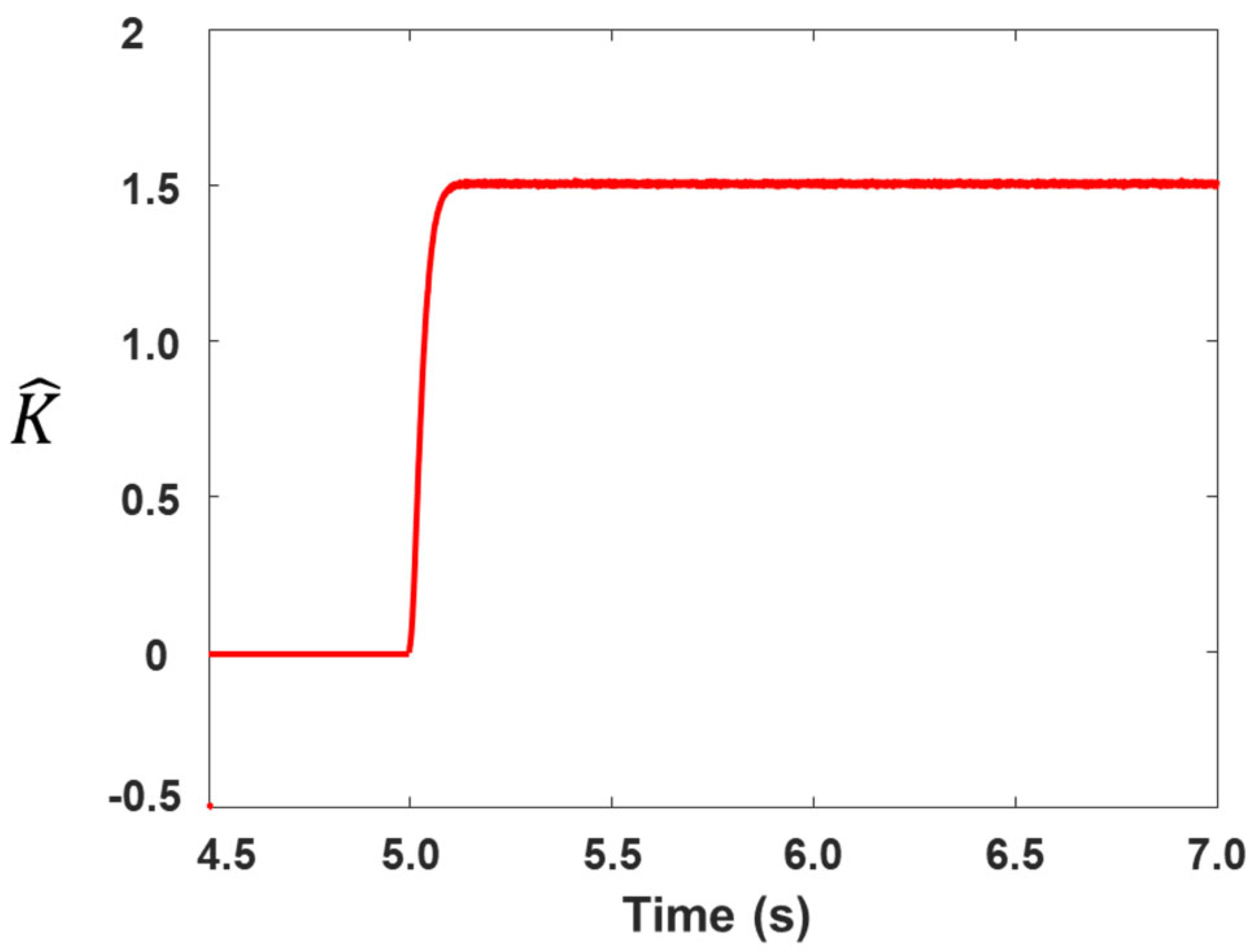An Improved Adaptive Sliding Mode Controller with Dynamic Surface Extension for Uncertain Robotic Manipulators †
Abstract
1. Introduction
2. Analytical Modeling of the Manipulator
- is the symmetric, positive-definite inertia matrix.
- collects Coriolis and centrifugal terms (chosen so that is skew-symmetric).
- is the vector of gravitational torque.
- captures frictional or viscous effects.
- is the vector of control torque.
- is a lumped matched disturbance (e.g., payload variation and unmodeled dynamics), bounded by .
3. Adaptive Controller Design
4. Results
- (i)
- RMS Torque Variationwhere is the chattering index, is the mean torque on joint , and s.
- (ii)
- Peak-to-Peak AmplitudeThe corresponding results for joint 1 are given in Table 1, which clearly indicates the effectiveness of the proposed adaptive controller.
| Metric | Traditional SMC | Proposed Method | Reduction |
|---|---|---|---|
| (N-m) | 0.046 | 0.027 | 41.3% |
| (N-m) | 0.21 | 0.13 | 38.1% |
5. Conclusions
Author Contributions
Funding
Institutional Review Board Statement
Informed Consent Statement
Data Availability Statement
Conflicts of Interest
References
- Zheng, S.; Ahn, C.K.; Wan, M.; Xie, Y.; Shi, P. Adaptive cooperative output regulation for multiple flexible manipulators. IEEE Trans. Syst. Man Cybern. Syst. 2024, 54, 4819–4831. [Google Scholar] [CrossRef]
- Zhao, W.; Sun, H.; Zhao, Z.; Liu, Y. Adaptive fault-tolerant control for flexible manipulators multiagent systems with unknown dead-zones under switching topology. IEEE Trans. Syst. Man Cybern. Syst. 2024, 54, 5412–5421. [Google Scholar] [CrossRef]
- de Souza, J.P.C.; Costa, C.M.; Rocha, L.F.; Arrais, R.; Moreira, A.P.; Pires, E.J.S.; Boaventura-Cunha, J. Reconfigurable grasp planning pipeline with grasp synthesis and selection applied to picking operations in aerospace factories. Robot. Comput.-Integr. Manuf. 2021, 67, 102032. [Google Scholar] [CrossRef]
- Lu, Q.; Chen, J.; Wang, Q.; Zhang, D.; Sun, M.; Su, C.-Y. Practical fixed-time trajectory tracking control of constrained wheeled mobile robots with kinematic disturbances. ISA Trans. 2022, 129, 273–286. [Google Scholar] [CrossRef] [PubMed]
- Zad, H.S.; Ulasyar, A.; Zohaib, A. Adaptive Observer Based Output Voltage-Tracking Control of DC-DC Boost Converters. In Proceedings of the 21st International Bhurban Conference on Applied Sciences and Technology (IBCAST), Murree Hills, Pakistan, 20–23 August 2024; pp. 584–588. [Google Scholar]
- Zhang, A.; Lin, Z.; Wang, B.; Han, Z. Nonlinear model predictive control of single-link flexible-joint robot using recurrent neural network and differential evolution optimization. Electronics 2021, 10, 2426. [Google Scholar] [CrossRef]
- Han, F.; Jia, Y. Sliding mode boundary control for a planar two-link rigid-flexible manipulator with input disturbances. Int. J. Control Autom. Syst. 2020, 18, 351–362. [Google Scholar] [CrossRef]
- Liu, S.; Yang, H.; Liu, Z.; Zhang, Z.; Li, Y. Observer-based independent joint control for a coupled rigid-flexible manipulator with actuator saturation based on distributed parameter model. J. Vib. Control 2023, 29, 5220–5233. [Google Scholar] [CrossRef]
- Sheh Zad, H.; Ulasyar, A.; Zohaib, A.; Khattak, A. Adaptive sliding mode predictive power control of three-phase AC/DC converters. Proc. Inst. Mech. Eng. Part I J. Syst. Control Eng. 2022, 236, 897–912. [Google Scholar] [CrossRef]
- Zad, H.S.; Ulasyar, A.; Zohaib, A.; Irfan, M.; Yaqoob, Z.; Haider, S.A. Robust & Optimal Predictive Current Control for Bi-Directional DC-DC Converter in Distributed Energy Storage Systems. Eng. Proc. 2024, 75, 26. [Google Scholar]
- Ahsan, M.; Salah, M.M.; Saeed, A. Adaptive fast-terminal neuro-sliding mode control for robot manipulators with unknown dynamics and disturbances. Electronics 2023, 12, 3856. [Google Scholar] [CrossRef]
- Zad, H.S.; Ulasyar, A.; Zohaib, A.; Irfan, M.; Haider, S.A.; Yaqoob, Z. Adaptive Sliding Mode Control of DC–DC Buck Converter with Load Fluctuations for Renewable Energy Systems. Eng. Proc. 2024, 75, 10. [Google Scholar]
- Lu, N.; Ma, L.; Hua, X. Nonsingular fast terminal sliding mode control based on neural network with adaptive robust term for robotic manipulators with actuators. Trans. Inst. Meas. Control 2022, 44, 2888–2899. [Google Scholar] [CrossRef]
- Zeinali, M.; Notash, L. Adaptive sliding mode control with uncertainty estimator for robot manipulators. Mech. Mach. Theory 2010, 45, 80–90. [Google Scholar] [CrossRef]




Disclaimer/Publisher’s Note: The statements, opinions and data contained in all publications are solely those of the individual author(s) and contributor(s) and not of MDPI and/or the editor(s). MDPI and/or the editor(s) disclaim responsibility for any injury to people or property resulting from any ideas, methods, instructions or products referred to in the content. |
© 2025 by the authors. Licensee MDPI, Basel, Switzerland. This article is an open access article distributed under the terms and conditions of the Creative Commons Attribution (CC BY) license (https://creativecommons.org/licenses/by/4.0/).
Share and Cite
Zad, H.S.; Zohaib, A.; Ulasyar, A.; Khalid, S. An Improved Adaptive Sliding Mode Controller with Dynamic Surface Extension for Uncertain Robotic Manipulators. Eng. Proc. 2025, 111, 25. https://doi.org/10.3390/engproc2025111025
Zad HS, Zohaib A, Ulasyar A, Khalid S. An Improved Adaptive Sliding Mode Controller with Dynamic Surface Extension for Uncertain Robotic Manipulators. Engineering Proceedings. 2025; 111(1):25. https://doi.org/10.3390/engproc2025111025
Chicago/Turabian StyleZad, Haris Sheh, Adil Zohaib, Abasin Ulasyar, and Sohail Khalid. 2025. "An Improved Adaptive Sliding Mode Controller with Dynamic Surface Extension for Uncertain Robotic Manipulators" Engineering Proceedings 111, no. 1: 25. https://doi.org/10.3390/engproc2025111025
APA StyleZad, H. S., Zohaib, A., Ulasyar, A., & Khalid, S. (2025). An Improved Adaptive Sliding Mode Controller with Dynamic Surface Extension for Uncertain Robotic Manipulators. Engineering Proceedings, 111(1), 25. https://doi.org/10.3390/engproc2025111025






